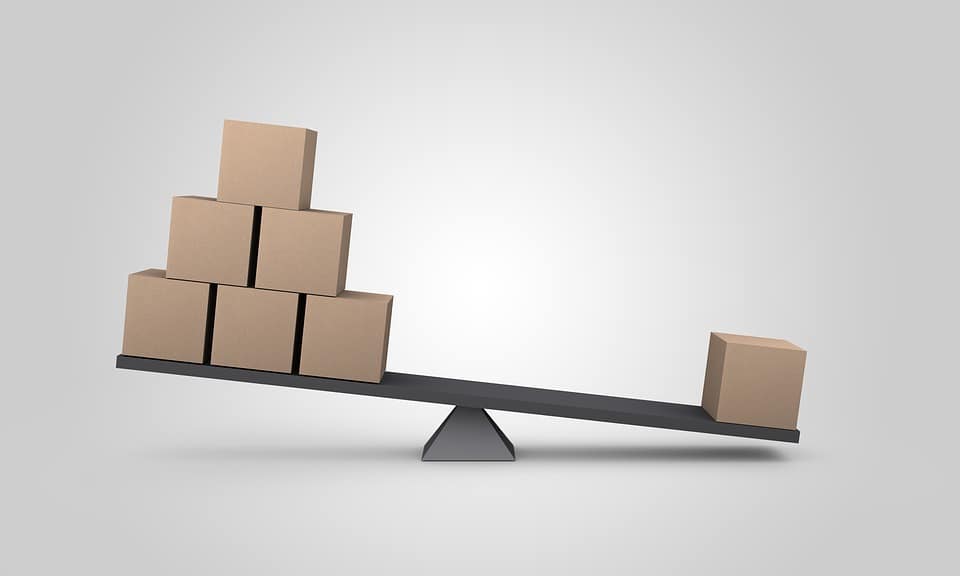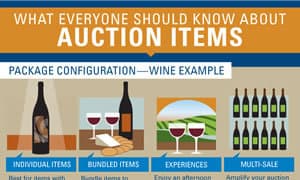
In the first article of this two-part series, we looked at the concept of choice overload and reviewed some of the pros and cons related to small auctions with few biddable items versus large auctions with many items.
We learned that because silent auctions are inherently unique events, caution should be taken to avoid a one-size-fits-all approach. The best results come with a personalized approach that employs (or at least takes into consideration) a set of tried-and-true best practices.
The standard formula
Fundraisers will often build a silent auction using a standard formula of one item per bidding unit. In this case, the term “item” encompasses both stand-alone objects and bundled packages, and “bidding unit” describes a couple (since most people attend events in pairs but typically only one person actively bids). In practice, we can divide in half our anticipated number of attendees to find out exactly how many items are best. For instance, an auction with 150 participants should contain 75 biddable items.
This formula, while not a hard and fast rule, is a helpful planning tool (especially for newer events). But don’t get too excited: this is not the one-stop solution it might seem and not all fundraisers would agree that this is the best ratio. Nevertheless, the standard formula is a good place to start and can prove very useful in establishing a size range. Indeed, most silent auctions will find that their sweet spot lies somewhere in this range. For example, the 150 participant auction planner might use this formulate a goal of 60-80 items or as justification to cap the number of items at 75.
Optimize the visual experience
Whether or not an auction feels crowded, sparse, or just right can depend as much on set-up and table organization as on the actual number of items. Venue size and layout are unavoidably central in shaping how an auction materializes, and good results are likely to stem from multiple pre-event site visits and thoughtful planning sessions. Keep in mind that cluttered and sparse auction tables alike act as a deterrent to bidders, as do haphazard mobile bidding sites.
Optimize the visual experience by keeping items evenly (and adequately) spaced. Use platforms and lighting to enhance your collection. Take care that small-sized items, like jewelry or stand-alone gift cards, don’t get lost in the shadows of large baskets. If your auction has a mobile bidding component, the user interface should appear similarly uncluttered. Using templates to ensure consistency in design and layout of printed and digital material (i.e. bidding sheets and package descriptions) will ensure a clean, polished look that bidders will appreciate.
Consider sections
 There are numerous ways to set-up an auction floor; oftentimes, planners will create sections. One popular school of thought is to section items according to theme, or at the very least, separate themed items from non-themed items. For example, a grade school benefit auction might have designated sections for school art and teachers experience packages; or, the auction might have tables set apart by grade. Alternatively, there are some planners who believe in mixing items together. One thing we can all agree on—the less wandering the better: get attendees to the packages and bidding. Design your auction with guests in mind; make it easy and intuitive. Differential sections can also be used as an organizational tactic to help with the closing and check-out process.
There are numerous ways to set-up an auction floor; oftentimes, planners will create sections. One popular school of thought is to section items according to theme, or at the very least, separate themed items from non-themed items. For example, a grade school benefit auction might have designated sections for school art and teachers experience packages; or, the auction might have tables set apart by grade. Alternatively, there are some planners who believe in mixing items together. One thing we can all agree on—the less wandering the better: get attendees to the packages and bidding. Design your auction with guests in mind; make it easy and intuitive. Differential sections can also be used as an organizational tactic to help with the closing and check-out process.
Bundle your way to success
One of the best things you can do to ensure that your auction is not only successful but aligns with best practices in the industry, is to adopt an overall strategy rooted in quality, not quantity. Don’t put stuff out just for the sake of it – this will only “water down the punch” (so to speak). But what happens if you find yourself knee deep in donated items and not all of them high value? The answer, of course, is to bundle.
This isn’t new information: combining items into bundles and baskets is at the heart of planning the silent auction. Be that as it may, auctions often fall into the trap of having too many selections for the audience size even with aggressive bundling. The truth is, many auctions stand to benefit from having fewer, higher value bundles. Set a deadline for donations, stick to it, and bundle until you hit your intended size range. (Just remember to create your bundles within a range of price points.)
Analytics and Reporting
At the end of the day, analytics and reporting are quite possibly the most beneficial activities that auction planners can undertake. It is always worth the time to put systems in place and collect data from the event. Planners might (wisely) choose to gather “soft” data – such as overall impressions and suggestions for improvement – and use this to tweak and modify future events. Methods for gathering soft data generally takes the form of post-event surveys (for participants) and debriefing sessions (for planners). “Hard” data consists of numbers and stats from the event; for silent auctions, the bulk of this can be found on the final bidding sheets.
Data collection is inherent in mobile bidding applications; auctions without a digital component can use techniques like carbon bidding sheets. Either way, planners must analyze the numbers if they are to find areas for improvement. A basic review of what sold high (and what didn’t) is a must, but don’t overlook more nuanced data sets, such as what items were popular but still sold far short of the true market value. This is proprietary information about your audience and tells you what to modify in subsequent events.
In conclusion
Building a silent auction is both art and science. There are no hard-and-fast rules to follow in a discussion of auction size, but we can tackle this question armed with a strategic blueprint. This blueprint provides the groundwork for finding that silent auction sweet spot, which as it turns out, may not be so elusive after all.
